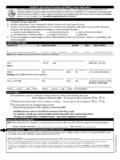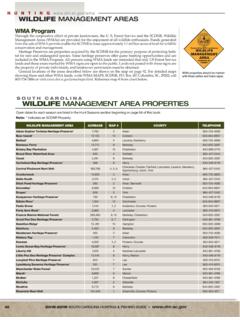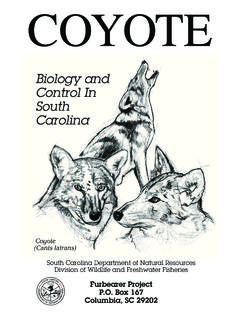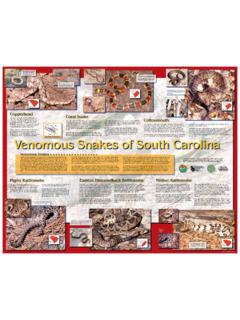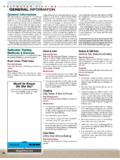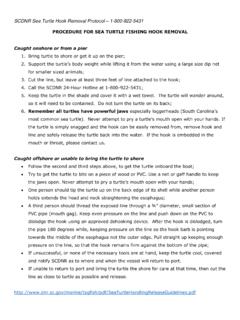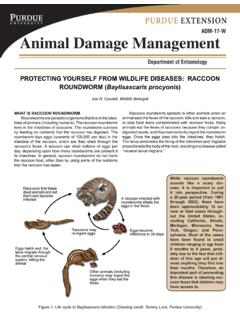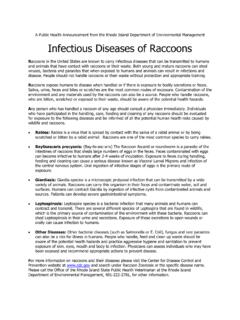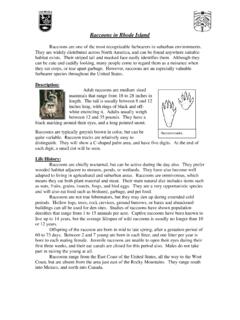Transcription of Raccoons
1 South Carolina Species Information Raccoons NWTCP South Carolina State species Information Page 1 Raccoons Prepared by the National Wildlife Control Training Program. Research-based, certified wildlife control training programs to solve human wildlife conflicts. Your source for training, animal handling and control methods, and wildlife species information. Figure 1. Raccoon (Procyon lotor). Photo by Greg Clements. Species Overview Conflicts Raccoons (Procyon lotor) cause considerable damage to several crops, especially sweet corn and sweet cherries. They can cause significant damage to turf while foraging for soil-borne insects. They kill poultry and take eggs.
2 Raccoons can damage structures when seeking access for denning in attics or chimneys. They carry rabies, and spread raccoon roundworm and other diseases. Legal Status In South Carolina, Raccoons are legally classified as a furbearer and can be taken by hunting or trapping during the open season. The season for trapping these animals is December 1 through March 1. Hunting season varies by game zone and even has an established season for running dogs. Anyone planning to hunt or trap Raccoons should be familiar with the regulations which govern these activities. Information on these regulations can be obtained online at: A nuisance raccoon can also be taken year-round with a Depredation Permit.
3 A depredation permit is not required when controlling nuisance Raccoons within 100 yards of a property owner s residence. This permit is issued by the Department of Natural Resources. To obtain a permit call your local wildlife management office or law enforcement field office .For further information: Identification Raccoons have a prominent black mask over their eyes, and a heavily furred, ringed tail (Figure 1). Physical Description Raccoons are stocky mammals about 2 to 3 feet long, and typically weigh 10 to 30 pounds. Their color is grizzled salt-and-pepper gray and black above, although some individuals are strongly washed with yellow. Species Range Raccoons are found throughout the US and are common in woodland, suburban, and agricultural areas.
4 Health and Safety Concerns Raccoons are the primary vector species for rabies in the eastern US. South Carolina Species Information Raccoons NWTCP South Carolina State Species Information Page 2 Raccoon roundworm (Baylisasacris procyonis) can cause blindness, brain damage, and death. Raccoons are not the only carrier of this parasite, but they are the definitive host. Avoid disturbing raccoon feces, and soil or other items contaminated by feces. General Biology, Reproduction, and Behavior Reproduction Raccoons mainly breed in February or March. Most litters of three to five young are born in April or May. Young first open their eyes at about 3 weeks, and are weaned between 2 and 4 months of age.
5 Family groups of Raccoons usually remain together for the first year with the young often denning with the adult female during winter. Nesting/Denning Cover Den sites typically include hollow trees, ground burrows, brush piles, muskrat houses, barns and abandoned buildings, dense clumps of cattails, haystacks, rock crevices, sewers, under sheds and porches, in chimneys, and attics. Behavior Adult males occupy territories of 3 to 20 square miles, females only 1 to 6 square miles. Adult males tend to be territorial and their ranges overlap very little. Raccoons do not truly hibernate, but they hole up in dens and become inactive during severe winter weather. Habitat Raccoons prefer hardwood forests near water.
6 They also live around farmsteads and livestock watering areas, far from naturally occurring bodies of permanent water. They frequently are found in wooded parks, where they obtain food from human sources. Food Habits Raccoons are omnivorous, eating both plants and animals. Plant foods include fruits, berries, nuts, acorns, corn, and other types of grain. Animal foods include crayfish, clams, fish, frogs, snails, insects, turtles and their eggs, mice, rabbits, muskrats, and the eggs and young of ground-nesting birds and waterfowl. They will readily take garbage and other food wastes. Voice, Sounds, Tracks, and Signs Raccoons emit several sounds including chirps, coos, chatter, distress calls, purrs, and complaints.
7 Raccoons usually leave plenty of signs of their presence. Latrines, where Raccoons regularly defecate (Figure 2), tend to be in areas open to the sky such as roofs, sand boxes, and fallen trees. Figure 2. Latrine of a raccoon. Photo by Stephen M. Vantassel. Damage Identification Raccoons are superb climbers. They frequently enter buildings by climbing trees or downspouts, or by shimmying up the side of a building. Look for smudge or scratch marks on trees or at the corners of buildings. Latrines on roofs and in attics are classic signs of Raccoons . Damage to Landscapes Raccoons roll up sod in search of earthworms and grubs. South Carolina Species Information Raccoons NWTCP South Carolina State Species Information Page 3 Damage to Crops and Livestock Raccoons can cause considerable damage to garden or truck crops, particularly sweet corn.
8 Damage to sweet corn is characterized by partially eaten ears with the husks pulled back. Raccoons also break stalks as they climb to get to the ears. Raccoons damage watermelons by digging a small hole in the melon and raking out the contents with a front paw. Raccoons often attack and kill poultry inside coops after tearing their way through doors or light woven wire. Dead birds often are mangled, with many feathers being bitten through. Damage to Structures Raccoons need only a 4-inch gap to enter a space. Raccoons learn that uncapped chimneys are good substitutes for traditional hollow trees used for denning sites. In extreme cases, Raccoons may tear off shingles or fascia boards to gain access to an attic or wall space.
9 Damage Prevention and Control Methods Habitat Modification Protect property by removing as many potential sources of food as possible. Only place plant matter ( , leaves and grass clippings) in compost piles to avoid attracting Raccoons , opossums, skunks, and other scavengers. Avoid leaving food and water out overnight for pets. Put free-ranging poultry in fenced, predator-proof coops overnight. Avoid planting sweet corn patches near creek bottoms or other wooded areas. Hang bird feeders on wire between trees, or on baffled poles to prevent raiding. Reduce the amount of seed that falls to the ground by using a single type of seed per feeder and using feeders that recapture fallen seed.
10 When Raccoons are rolling up freshly laid sod to find grubs, pin the strips of sod down with long wire pins, wooden stakes, or nylon netting to allow the grass to take root. Application of insecticides to control grubs is effective only if done before damage by Raccoons begins. Exclusion Exclusion usually is the best method for managing damage by Raccoons . Damage to sweet corn or watermelons can be stopped almost immediately by excluding Raccoons with an electric fence with two wires set at 6 inches and 12 inches from the ground respectively. Use electric fences with care and install appropriate caution signs to warn people. Prevent climb-overs of conventional fences by adding an electric wire attached to a fence charger several inches below the top of the fence.
